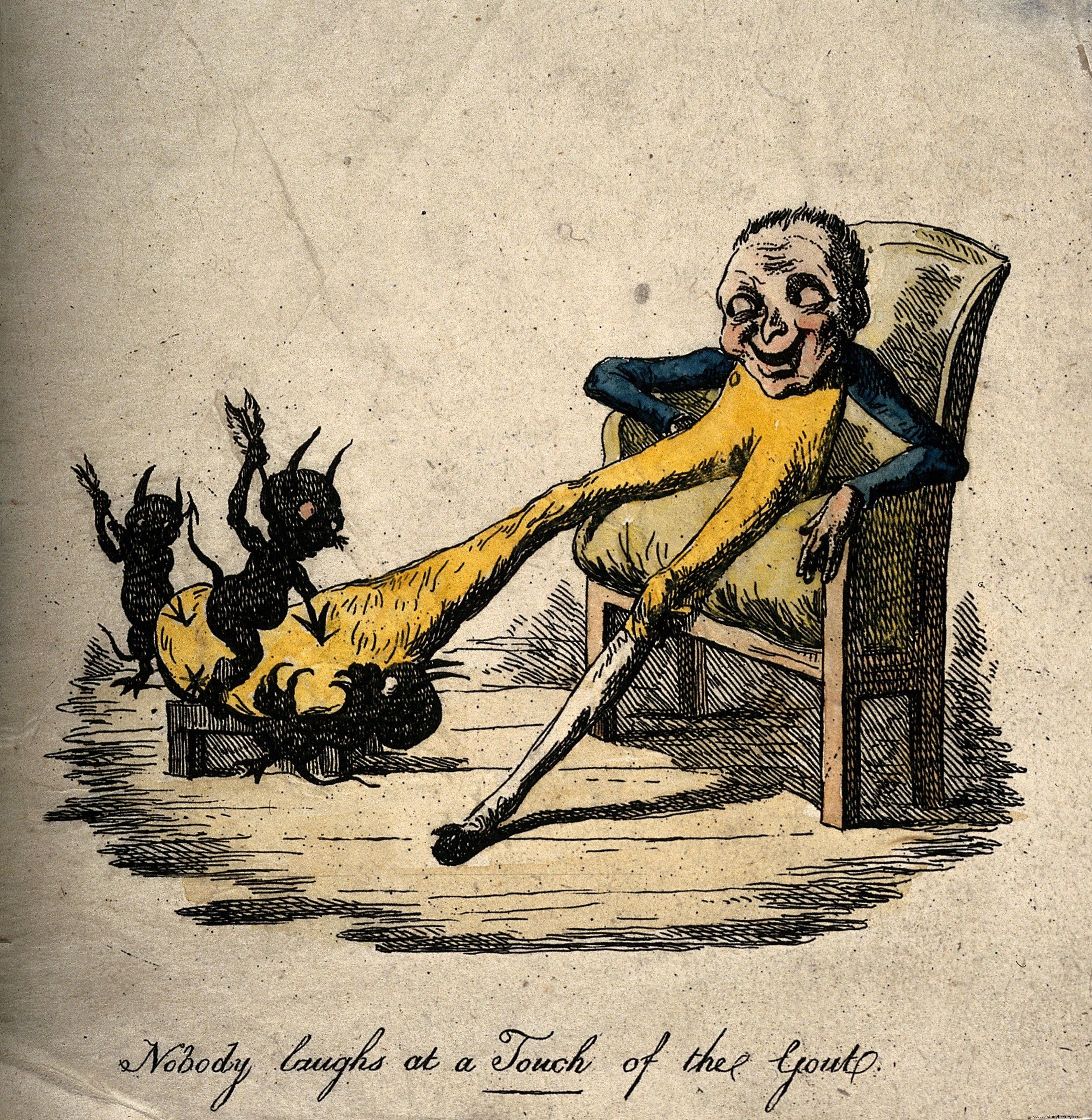The Egyptians were the first to identify it. Hippocrates wrote extensively about her. Those she touched suffered the most real torments. As there was no effective cure, the terrible pain would haunt them for the rest of their lives. Or else they were killed by equally horrible complications.
Gout, popularly known as gout, is one of the oldest known rheumatic diseases. In keeping with the spirit of the Middle Ages and the humoral theory, it was explained that its cause was a problem with ... one of the moods.

Gout, satirical illustration (photo:public domain)
Randoplhus of Bocking (1197-1258), chaplain to the bishop of the English city of Chichester, wrote extensively on this subject. He explained that human health is directly dependent on the balance of moods. In his opinion, the gout was the result of the imbalance in question. Under certain circumstances, one of the humors "dripped" into the joint, causing great pain and redness and swelling. Anyway, this theory corresponds to the English name of the disease - gout - derived from the Latin word "gutta", meaning a drop.
Gout even had a specific "candidate profile". First of all, it was considered a disease of kings (and so it was sometimes called), although only a fraction of the sick had blue blood in their veins. The rest had money and aspirations. As George Nuki and Peter A. Simkin commented in an article devoted to the history of gout, paradoxically, in certain periods, gout was socially desirable because of its prevalence among people considered powerful. Moreover, many believed that people who contracted this disease were protected from other serious ailments.
Does this disease have a gender?
For centuries, gout has been considered a disease that almost only one sex likes. It was only in the times of Nero that Seneca noticed that women could also suffer from gout. The philosopher was to write down:
At this age, women compete with men in all sorts of lavishness ... So why would we be surprised to see so many women affected by gout?

A man suffering from gout in a 19th-century illustration (photo:public domain)
Gout is characterized by uric acid build-up in the joints. This causes inflammation and penetrating pain. Usually, the symptoms attack at night and last for many hours. They are connected with fever, swelling and fatigue. Patients' pain is so strong that they are unable to move on their own. As the English physician Thomas Sydenham commented:
The patient goes to bed and sleeps soundly until about two in the morning when he is awakened by pain that affects the big toe, sometimes the heel, calf, or ankle. Pain is similar to that caused by bone displacement. Immediately there is a feeling of coldness, chills and a slight fever. The pain, which is mild at first, grows stronger with each passing hour. So severe that the patient cannot bear the weight of the clothes or the vibrations caused by a person moving briskly around the room.
Gout health for the first time!
Why has gout become "the disease of the rich"? This was due to a simple relationship between lifestyle and the likelihood of developing the disease. It increased tremendously in obese people who indulged in eating and drinking.
Gout "participated" in many historical events. The kings suffered from it, and therefore could not lead their armies into battle. It tormented popes and emperors. Henry VIII and Benjamin Franklin suffered from it. The Italian Medici family took a special liking to gout. Passing practically from generation to generation, she made life difficult for other family members.
The third ruler of Florence from this dynasty, Lawrence, turned out to be an outspoken politician. He was able to raise the prestige of the family to such an extent that many Italian princes treated him in a sense as a sovereign. He was a charismatic diplomat and an efficient politician, unless… he was getting a gout attack. Like his father and grandfather, he had to endure unexpected bouts of pain that completely disturbed him.
Instead of constantly staying in Florence, he was constantly looking for relief by visiting other spas in Tuscany. Anyway, with poor results. As Mary Hollingsworth describes in her book, Medici. The secret history of the dynasty " , Lawrence was scouring the Apennine Peninsula in search of a cure. Unfortunately, no effective remedy existed:
Spedaletto wrote to his youngest daughter, Contessina:“constant bathing helps me a lot, so I hope that with God's help I will come back to you in full health; I'm going back soon ”. Despite such optimistic announcements, he realized that he was very sick [...]. Various treatments have been suggested. One of the doctors sent a prescription for the ointment and promised that this summer he would provide Lawrence with "a red stone that grows in the swallow's stomach" and which should be "wrapped in linen cloth and sewn into a shirt at the nipple level of the left breast"

It is hard to guess what else Lawrence Medici would have achieved if he had not been killed by gout (photo:public domain)
Bouts of severe pain prevented Lawrence from fulfilling his duties as the head of the republic. The suffering was so great that he was unable to receive visitors, so diplomats from other Italian states had to wait for his condition to improve. In Mary Hollingsworth's book, we can read that a physician in 1491 ordered him to protect his feet from moonlight, cold, and dampness. He was also forbidden to eat pears and grape seeds.
Despite following all recommendations and strenuous searches for a panacea, Wawrzyniec did not manage to combat the disease. On April 8, 1492, he died of gout complications, as did his father (who is called Piotr Podagryk) and grandfather. Medici's personal physician until the end insisted that his employer would recover. The day after Lawrence's death, the doctor committed suicide.
